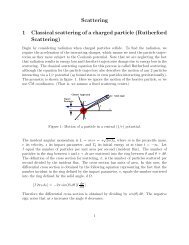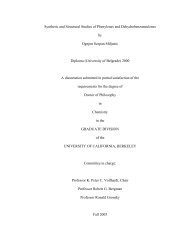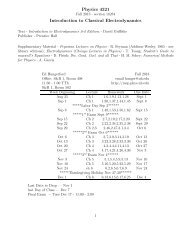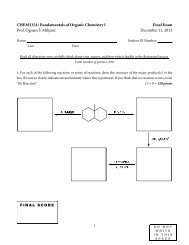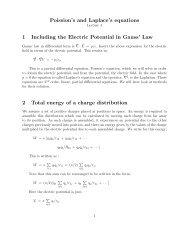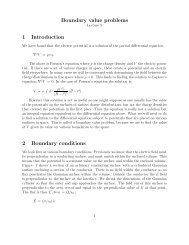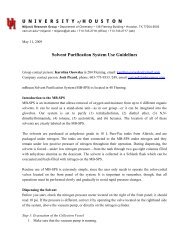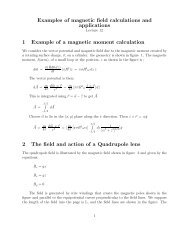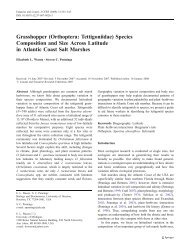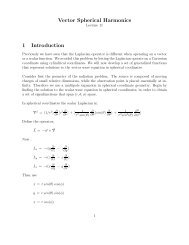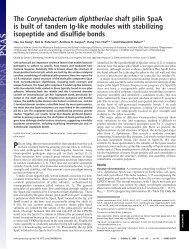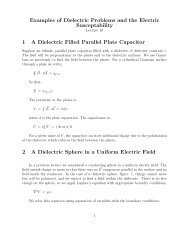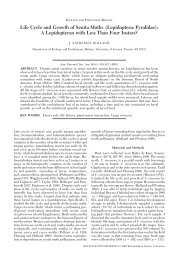Solution to Laplace's Equation in Cylindrical Coordinates 1 ...
Solution to Laplace's Equation in Cylindrical Coordinates 1 ...
Solution to Laplace's Equation in Cylindrical Coordinates 1 ...
You also want an ePaper? Increase the reach of your titles
YUMPU automatically turns print PDFs into web optimized ePapers that Google loves.
G 0 = [ J 0(k n ρ)<br />
J 0 (k n c) − N 0(k n ρ)<br />
N 0 (k n c) ]<br />
So that at ρ = c, the cyl<strong>in</strong>drical surface of the <strong>in</strong>ner cyl<strong>in</strong>der, G 0 vanishes. Note we have<br />
chosen ν = 0 because the potential is <strong>in</strong>dependent of φ, ie the problem is aximuthally symmetric.<br />
Now we must choose the values of k n <strong>to</strong> make G 0 = 0 when ρ = a. This will select<br />
a set of zeros, α νn , of the function, G 0 , and <strong>in</strong> fact make the functions, G 0 , a complete<br />
orthogonal set. This po<strong>in</strong>ts out that we separated the solutions of the radial ode <strong>in</strong><strong>to</strong> a<br />
form which was regular at ρ = 0 and one which was not. But we could have separated the<br />
solutions so that, G 0 , was one of the two l<strong>in</strong>early <strong>in</strong>dependent solutions, and thus it would<br />
have similar oscillat<strong>in</strong>g properties as the function J ν . Of course the location of the zeros<br />
would be different. Use orthogonality <strong>to</strong> obta<strong>in</strong> the coefficients <strong>in</strong> the above equation.<br />
Here;<br />
H A n = [1/s<strong>in</strong>h(k n b)]<br />
H =<br />
∫ a<br />
c<br />
ρdρ G 2 (α n ρ/a)<br />
∫ a<br />
c<br />
ρdρ V (ρ) G(α n ρ/a)<br />
F<strong>in</strong>ally consider the problem with the cyl<strong>in</strong>drical wall held at potential V = f(z) and<br />
the endcaps grounded. This geometry is shown <strong>in</strong> figure 6. The boundry conditions are;<br />
z = 0, b V = 0<br />
ρ = a V = f(z)<br />
In this case we cannot use the hyperbolic function <strong>in</strong> z <strong>to</strong> match the boundry conditions.<br />
However if we let k → ik then the hyperbolic function becomes harmonic at the expense of<br />
mak<strong>in</strong>g the argument of the Bessel function complex. Note here that the problem is 2-D<br />
so we expect only one eigenfunction and this now occurs for the z coord<strong>in</strong>ate. Then the<br />
radial ode with complex Bessel function solutions cannot be eigenfunctions. The eigenvalue<br />
of k = nπ/b is determ<strong>in</strong>ed by the harmonic form;<br />
s<strong>in</strong>(nπz/b)<br />
n <strong>in</strong>tegral<br />
The solution has the form;<br />
V = ∞ ∑<br />
n=1<br />
A n s<strong>in</strong>(nπz/b) J 0 (<strong>in</strong>πρ/b)<br />
In this case we use the orthogonality of the harmonic functions rather than the Bessel functions.<br />
The value of the coefficients are;<br />
7




